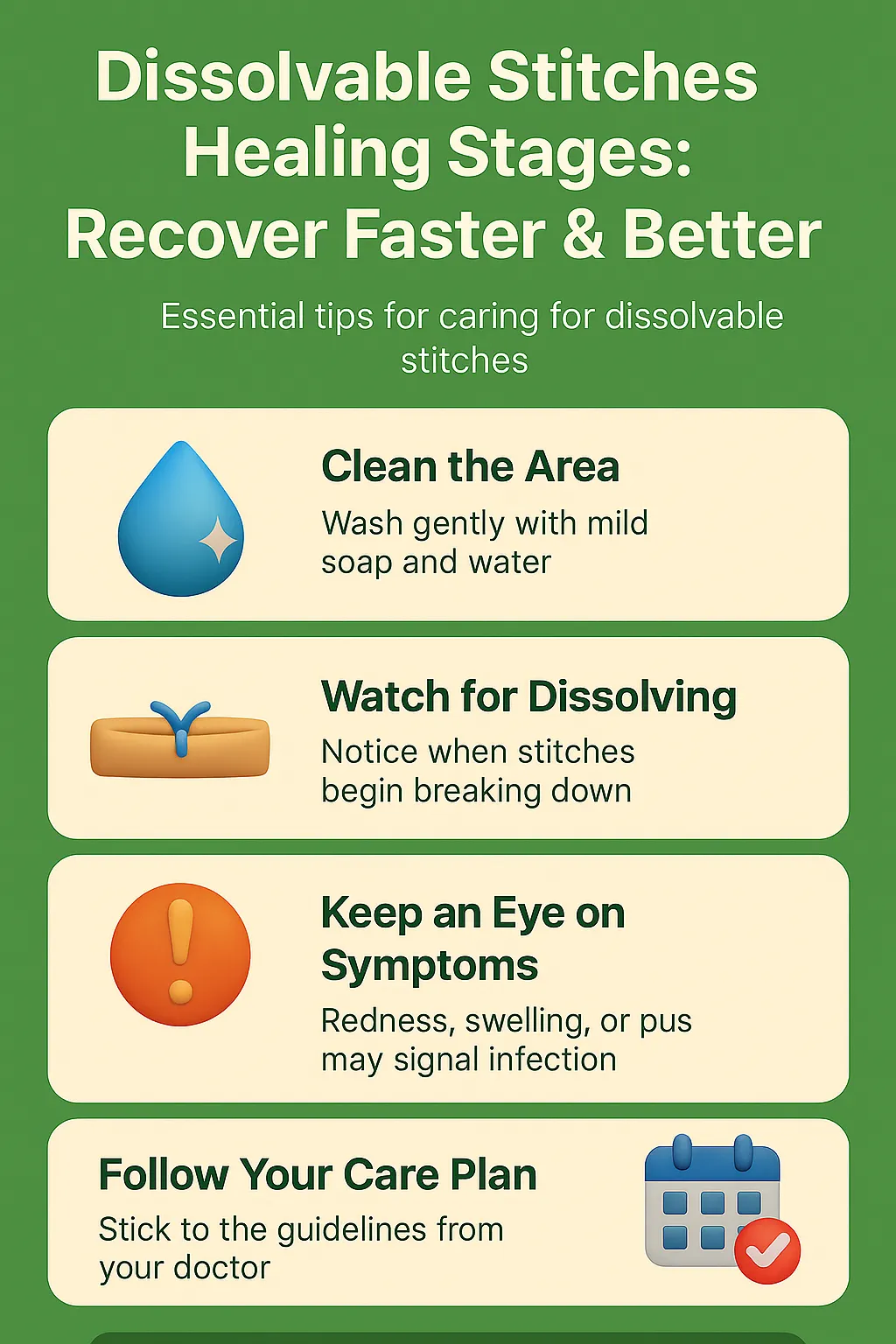Drawing on years of patient recovery experience, this guide offers a practical, experience-driven look at dissolvable stitches healing stages and how dissolvable stitches heal.—and how you can actively speed up and improve the process. Recovery isn’t just about waiting for stitches to disappear; each stage brings unique changes and opportunities to support your body’s natural repair. Backed by real-world case examples, we’ll highlight clear signs of progress, potential setbacks, and evidence-based aftercare strategies for smoother, more efficient healing.
Top Takeaways
- Knowing each stage lets you recognize progress and act early if something changes.
- Clean wound care, proper rest, and healthy habits are essential for a faster, better outcome.
- Education and awareness can reduce healing complications by up to 40%.
Stages of Healing with Dissolvable Stitches
Dissolvable stitches, or absorbable sutures, are designed to naturally break down in the body as the wound heals—so no removal is necessary. Healing generally progresses through these stages:
- Initial Stage (Days 1–3): Mild swelling, redness, and tenderness as the wound begins repairing. Stitches hold the tissue in place to stabilize healing.
- Early Healing (Days 4–7): Swelling decreases, new tissue develops, and stitches may feel slightly looser as the wound strengthens.
- Mid-Healing (Weeks 2–3): Stitches soften and start absorbing; mild itchiness is common as skin repairs itself.
- Final Stage (Weeks 4–6+): Most stitches dissolve, leaving a maturing scar that will continue to strengthen for months.
Faster Recovery Tip: Keep the area clean, follow your surgeon’s instructions carefully, and avoid any activity that might strain or pull at the stitches.
"In my experience, the best recoveries happen when patients know exactly what each stage should look and feel like. It’s this awareness that allows them to spot healthy progress, react quickly to concerns, and avoid preventable setbacks, leading to successful wound healing."
Case Study & Real-World Insights
Case Study: Smooth Recovery After Knee Surgery
- Arthroscopic knee surgery closed with dissolvable stitches.
- First 72 hours: mild swelling and redness—normal early signs.
- Day 5: inflammation decreased; healthy tissue growth visible.
- Week 2: stitches softened, indicating absorption.
- Week 5: stitches dissolved completely; scar was faint and flat.
- Keys to success: diligent wound cleaning, avoiding high-impact activity, and close monitoring.
Example: Delayed Recovery from Overexertion
- Abdominal surgery with dissolvable stitches.
- Heavy lifting resumed just one week post-op.
- Result: wound partially reopened, delaying healing by about three weeks.
- Lesson: pushing too hard too soon can undo progress and extend recovery time.
Supporting Statistics
- Infection Risk: Roughly 157,500 surgical site infections occur in the U.S. each year, with about half being preventable (CDC).
- Pre-Op Activity Benefits: Walking 7,500+ steps daily before surgery can lower the risk of complications by 51% (American Academy of Orthopaedic Surgeons).
- Hospital Recovery Programs: Enhanced recovery protocols in 300+ hospitals have reduced complications and shortened hospital stays (AHRQ).
Key Insight: Combining preparation, prevention, and consistent aftercare leads to faster, better recovery outcomes.
Final Thought & Opinion
Healing with dissolvable stitches is an active process that benefits from your daily attention and care. The best recoveries happen when you respect the healing timeline, protect the wound, and make smart lifestyle choices. Understanding each stage builds confidence, improves results, and helps you heal faster and better.
Next Steps
- Follow your surgeon’s care plan – Every detail matters.
- Check the wound daily – Watch for normal healing signs and catch issues early.
- Support your health – Eat nutrient-rich foods, stay hydrated, and keep light activity if cleared.
- Avoid strain – Skip heavy lifting and high-impact movements until advised.
- Keep appointments – Ensure your healing stays on track.
Act promptly – Contact your provider if you notice unusual symptoms.
Frequently Asked Questions
How long do dissolvable stitches take to fully dissolve?
Most dissolve within 4–8 weeks, but this can vary depending on the suture material, the type of procedure, and your body’s healing response.
What are the key stages of healing for dissolvable stitches?
- Initial (Days 1–3): Swelling, redness, and tenderness.
- Early (Days 4–7): Reduced swelling, early tissue growth.
- Mid (Weeks 2–3): Stitches soften and start absorbing.
- Final (Weeks 4–6+): Stitches dissolve, scar continues to strengthen.
What can I do to recover faster and better with dissolvable stitches?
Follow your surgeon’s aftercare instructions, keep the wound clean and dry, avoid activities that strain the area, eat a nutrient-rich diet, stay hydrated, and attend all follow-up appointments.
What signs indicate my dissolvable stitches might not be healing properly?
Seek medical advice if you notice worsening redness, swelling, warmth, severe pain, bleeding, pus, foul odor, bеdsоrеs, or if stitches remain long past the expected dissolution period.
Can I exercise while my dissolvable stitches heal?
Light walking may be allowed to promote circulation if approved by your doctor, but avoid heavy lifting, stretching, or high-impact exercise until your healthcare provider confirms it’s safe.
Just as proper wound care can determine the speed and quality of recovery, keeping your home’s air systems clean and efficient plays a similar role in maintaining overall wellness during healing. For instance, scheduling Dryer Vent Cleaning in Alachua, FL ensures a safer indoor environment free from excess dust and allergens, which can benefit those recovering from surgery. Regular checkups from HVAC Tune-Up Companies can help keep air quality optimal—important for minimizing irritants that might impact sensitive healing skin. Using high-quality filters like the Platinum 20x23x1 Pleated Filters or the Filterbuy 12x18x1 MERV 8 Pleated HVAC AC Furnace Air Filters can help trap airborne particles, reducing the risk of infection for those with healing wounds. Even finding quality air filtration solutions from sources like eBay can make a difference, aligning with the principles in Dissolvable Stitches Healing Stages: Recover Faster & Better by creating a cleaner, more supportive recovery environment.





